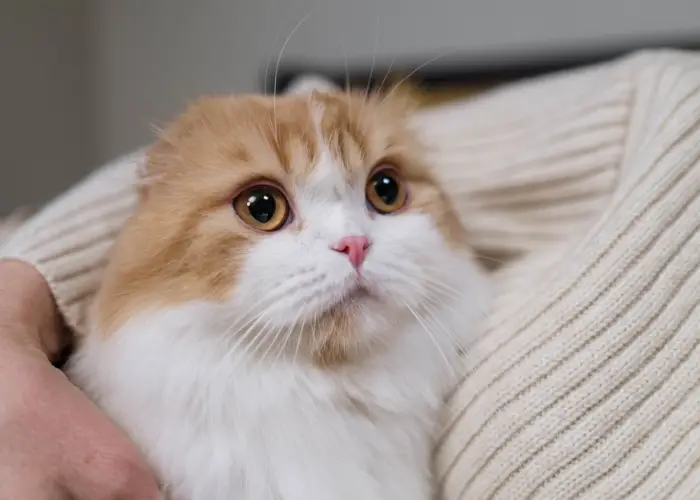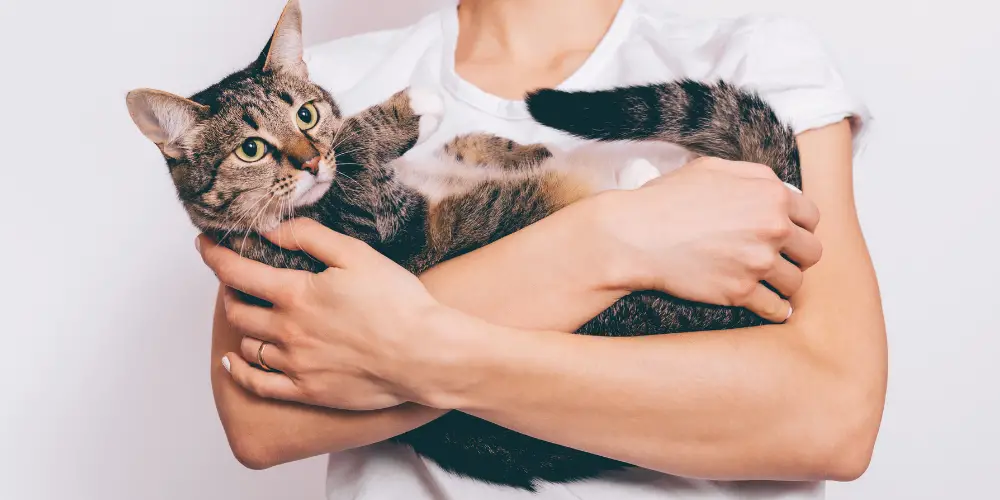Have you ever found yourself on a lazy afternoon, gently stroking your cat and pondering, “Why is this little creature so unbelievably soft?”
As we dive deeply into the five primary reasons, we’ll uncover how each element contributes to that silky sensation that makes our feline friends irresistibly cuddly.
1. Unique Fur Structure
At the heart of a cat’s softness lies its unique fur structure. Each strand of fur is a marvel of nature’s design, with cuticle scales that lie almost invisibly flat against the hair shaft.
This microscopic architecture gives cat fur its lustrous appearance and incredibly smooth texture.
Unlike the more robust fur of other animals, cat hairs are fine and exquisitely arranged, resulting in a texture that’s not just soft, but also has a luxurious, almost silky feel.
But the magic doesn’t end there. A cat’s fur comprises three distinct layers: the outer guard hairs, the middle awn hairs, and the innermost down hairs.
Each layer has its role, from protecting against the elements to providing insulation. Yet, the downy undercoat indeed contributes to that cloud-like softness we adore.
2. Grooming Habits
If cats had a mantra, it would probably be “groom; therefore I am.” Cats dedicate a significant chunk of their day to grooming, a practice about more than just cleanliness.
This meticulous grooming ritual helps to distribute the cat’s natural oils evenly across its fur, ensuring each strand is effectively conditioned.
This not only keeps their coat gleaming but also maintains its softness and prevents the formation of mats and tangles. It’s this constant care that keeps their fur in such pristine condition.
Moreover, grooming is more than a solo task for cats. Social grooming, or allogrooming, is a bonding activity that keeps hard-to-reach areas soft and clean.
So, every lick and nibble between feline friends is a step towards maintaining their collective softness.
3. Genetics and Breed Influence
Like us, cats inherit many traits from their lineage, and fur softness is among them.
Certain breeds are synonymous with softness, thanks to their genetic predispositions.
For instance, the luxurious coats of Siamese and Balinese cats are not just by chance but directly result from their specific genetic makeup.
But it’s not all about the breed. Even within a single breed, there can be a wide range of fur textures, all thanks to the diverse genetic lottery of softness.
This genetic variance ensures that each cat is unique in its softness, with some cats naturally having a softer coat than others, regardless of their breed.
4. Diet and Nutritional Impact
The saying “you are what you eat” rings especially true for cats and their fur.
A balanced diet, rich in essential nutrients like proteins and fatty acids, is crucial for a healthy, soft coat. These nutrients are the building blocks of a cat’s fur, ensuring each strand is strong, resilient, and, most importantly, soft.
Omega-3 and omega-6 fatty acids, in particular, play a significant role in maintaining the health of a cat’s skin and fur.
They help reduce inflammation and hydrate skin, ensuring the fur is soft and lustrous. So, a cat’s diet is directly linked to the cuddliness of its coat.
5. The Comfort of a Stress-Free Environment
Last but not least, the cat’s environment dramatically influences the softness of its fur.
Stress can harm a cat’s coat, leading to issues that affect its condition and softness. Conversely, a serene and loving home can improve a cat’s fur quality.
The small comforts—like a cozy bed, a quiet corner for retreat, and the security of a stress-free home—contribute to a cat’s overall well-being.
And when a cat feels safe and content, it shows in the softness and health of its fur. A happy cat is, more often than not, a soft cat.
Conclusion

In weaving together these threads of biology, care, genetics, nutrition, and environment, we gain a deeper appreciation for the softness of our feline companions.
It’s a softness that’s not just felt but deeply intertwined with their very nature and well-being.
So, the next time you find yourself lost in the softness of your cat’s fur, remember the myriad factors that make that moment of tenderness possible.
RELATED POST: Are Cats Haram?
FAQs
Why is a cat’s fur softer than a dog’s?
Cats’ fur tends to be softer than dogs‘ due to their unique fur structure, including a fine undercoat and awn hairs, which many dog breeds lack. Cats also spend more time grooming, which distributes natural oils and enhances softness.
Why is my cat super soft?
Your cat may be super soft due to a combination of genetics, meticulous grooming habits, a nutritious diet, and a stress-free environment, all of which contribute to the health and softness of their fur.
Are cats the softest animal?
While cats are incredibly soft, whether they are the softest is subjective and depends on personal experience. Different animals have unique fur textures, but cats are renowned for their silky coats due to their grooming habits and fur structure.
How long do cats stay soft?
Cats can maintain their softness throughout their lives with proper care, including regular grooming, a balanced diet, and a healthy living environment. However, the texture of their fur may change with age and health conditions.


